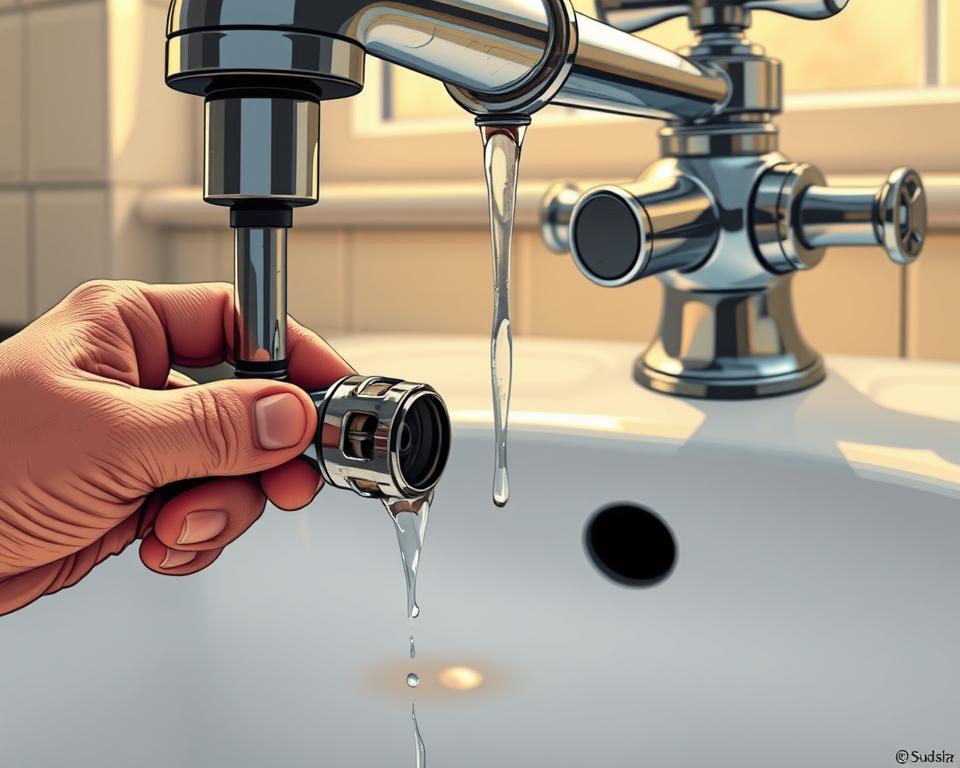DIY Guide: How to Replace Faucet Valve Seats
Did you know a leaky fixture can waste over 3,000 gallons of water a year? That volume could fill a kiddie pool! Fixing worn-out components saves money and conserves water—no plumbing experience needed.
Our step-by-step guide keeps it straightforward. Armed with tools and parts from Installation Parts Supply, you’ll fix drips quickly. Skip costly plumber fees and enjoy a drip-free home using valve seat faucet.
Adhere to these instructions for an easy replacement. Quality materials ensure lasting results, and you’ll gain confidence tackling future projects.
Summary Highlights
- Leaks waste water and increase bills—quick fixes prevent damage.
- DIY repairs save money compared to hiring a professional.
- High-quality parts from trusted suppliers improve durability.
- Basic tools and clear guidance suit any skill level.
- Routine care prolongs fixture lifespan.

Why You Should Replace Worn Valve Seats
A tiny leak feels minor—until it causes major issues. Damaged valve seats leak water, boost bills, and risk fixture damage. Addressing leaks promptly prevents expense and disruption.
Detecting a Worn Valve Seat
Look out for:
- Water drips despite a snug handle.
- Variable water pressure and uneven spurts.
- Corrosion spots or pitting on metal.
Kitchen drips hinder cooking and leave unsightly marks. Timely action prevents bigger headaches.
The Mechanics of Valve Seat Wear
Mineral deposits and constant friction wear down parts over time. This creates gaps where water escapes. Unchecked wear on the valve seat may wreck the faucet.
Count on Installation Parts Supply for robust parts. Their parts resist buildup, ensuring a tight seal and lasting performance.
Quick leaking faucet repair protects your home and conserves water—up to 3,000 gallons yearly!
Required Tools & Parts
The right kit makes for a durable, leak-proof repair. Whether you’re tackling a minor drip or a stubborn leak, the right supplies save time and hassle. Collect the following tools and parts:
Tools You Need
Essential plumbing tools:
- Adjustable wrench—to loosen retaining nuts.
- Valve-seat wrench for seat extraction.
- Phillips and flat-head screwdrivers for disassembly.
- Needle-nose pliers for tight spots.
Use a seat-grinding bit to clean badly corroded seats. A faucet repair kit with seats, washers, and O-rings covers most replacements.
Parts Sources
Skip generic parts that wear out quickly. Installation Parts Supply stocks long-lasting, compatible parts across the US. Their kits include everything for a tight seal, backed by expert support.
| Must-Haves | Optional (For Advanced Jobs) |
|---|---|
| Adjustable spanner | Seat grinding tool |
| Valve-seat remover | Heat source |
| Repair kit | Pipe cutter |
Investing in reliable tools and parts pays off. You’ll avoid repeat repairs and enjoy a drip-free home for years.
How to Replace the Valve Seat
End water waste with this easy DIY repair anyone can do. Whether you’re a beginner or a seasoned DIYer, these steps ensure a smooth process. Ready your tools and dive in.
Step 1: Turn Off Water & Disassemble
Locate the shutoff valves under the sink and turn them clockwise. Turn the faucet on to drain any water left. Use a screwdriver to remove the handle, then unscrew the retaining nut with an adjustable wrench.
Tip: Tag components with labels so you know where they go. Installation Parts Supply’s anti-corrosion nuts extend service life.
Step 2: Extract the Worn Seat
Check for buildup and wear. Use the seat wrench to back out the damaged seat. For stubborn cases, apply penetrating oil and wait 10 minutes before retrying.
| Typical Issues | Solutions |
|---|---|
| Stuck seat | Apply gentle heat or locking pliers |
| Stripped threads | Replace the entire housing |
Step 3: Install the New Valve Seat
Wire-brush the hole to clear corrosion. Thread in the new seat from Installation Parts Supply and start by hand. Finish with the wrench, but avoid over-tightening to prevent cross-threading.
Step 4: Put It Back Together & Test
Reattach components in reverse order. Open the shutoff valves gradually. Check for drips—if leaks persist, tighten connections incrementally. Master this fix to conserve water and cash!
In Closing
Enjoy peace of mind with sturdy, leak-free plumbing. Addressing issues promptly conserves water and money.
With this guide’s clear steps, anyone can tackle the job confidently. Count on Installation Parts Supply for parts that withstand wear.
Keep your faucet in top shape by checking washers each year and snugging handles. Minor upkeep goes a long way in avoiding future headaches.
Ready to put your skills to work? Grab your tools, follow the steps, and enjoy a drip-free home today!
